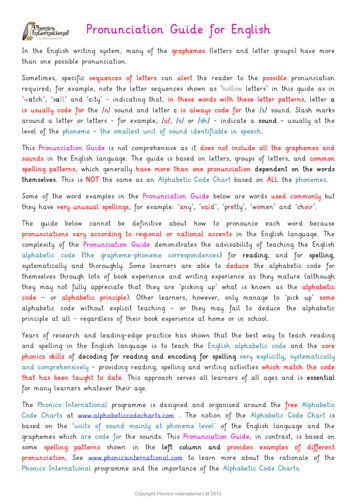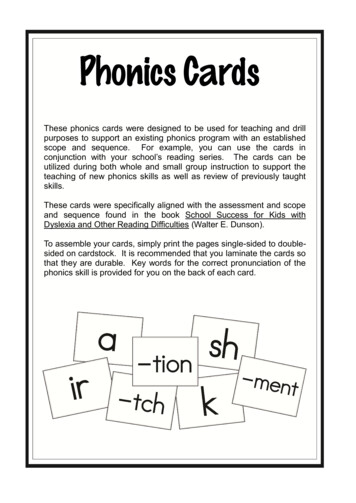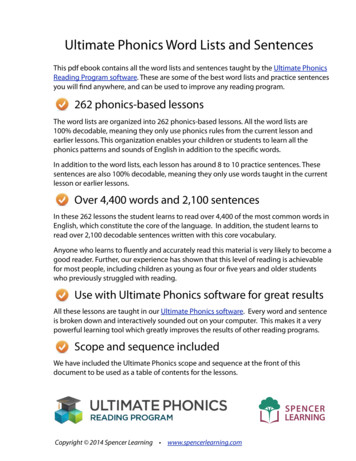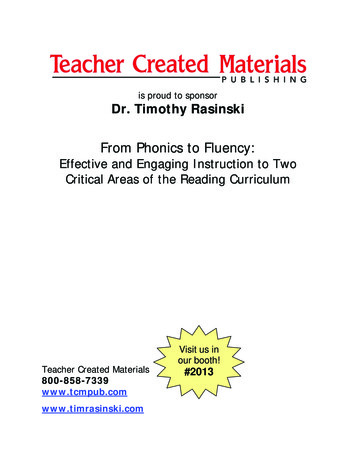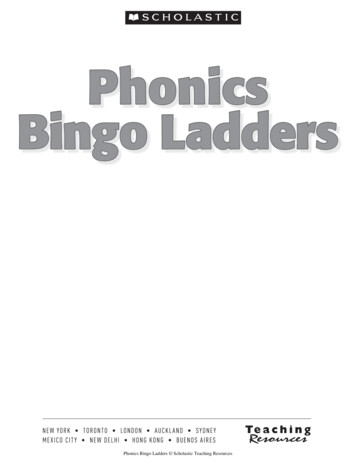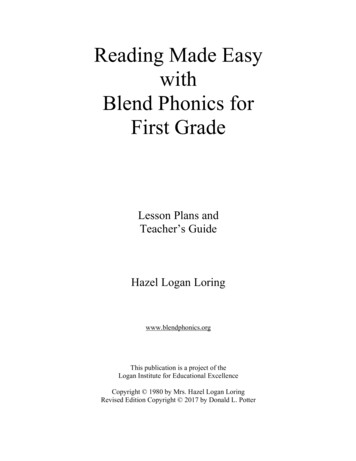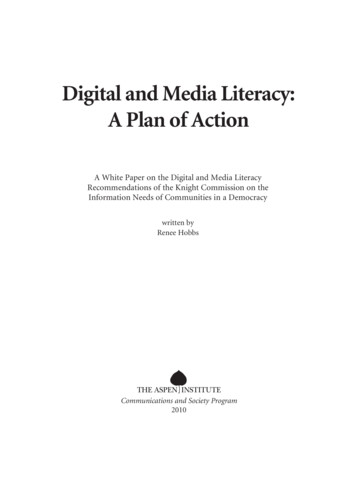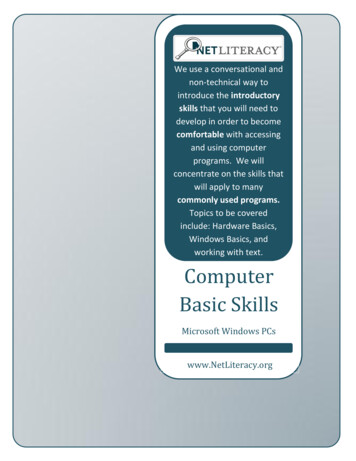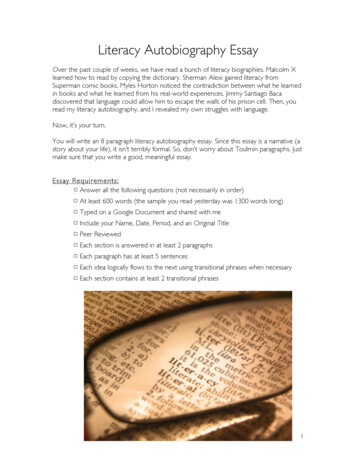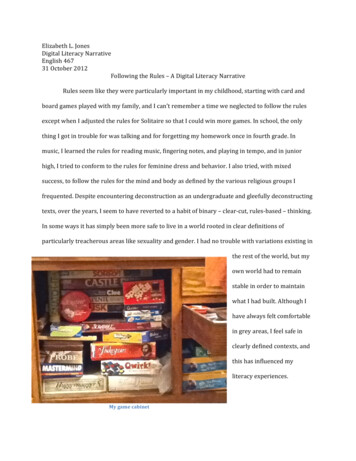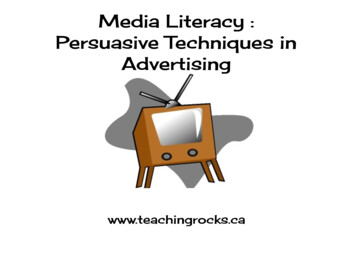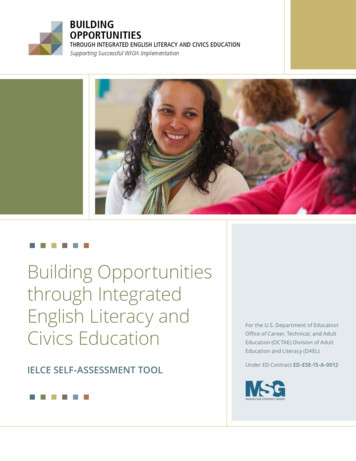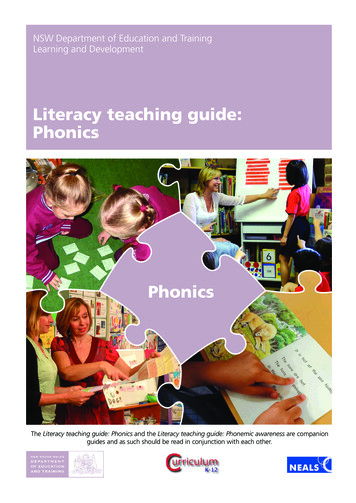
Transcription
NSW Department of Education and TrainingLearning and DevelopmentLiteracy teaching guide:PhonicsPhonicsThe Literacy teaching guide: Phonics and the Literacy teaching guide: Phonemic awareness are companionguides and as such should be read in conjunction with each other.
Literacy teaching guide:PhonicsThe Literacy teaching guide: Phonics and the Literacy teaching guide: Phonemic awareness are companionguides and as such should be read in conjunction with each other.
Literacy teaching guide: Phonics State of New South Wales through the Department of Education and Training, 2009. This workmay be freely reproduced and distributed for personal, educational or government purposes.Permission must be received from the Department for all other uses.Licensed Under NEALSISBN 9780731386093SCIS 1363832Page 2
Literacy teaching guide: PhonicsForewordThis teaching guide on phonics is one of a series of connectedresources to support literacy teaching.These resources incorporate the most recent research on literacy andliteracy education, the findings of national and international reviewsand teachers’ experience with, and feedback on literacy supportmaterials that the Department has produced in the past.This guide needs to be read and used in conjunction with that onphonemic awareness, which has been simultaneously published. Thesetwo critical aspects of literacy need to be taught and learned together.The teaching of phonics has been the subject of some public debate. The Department’s position isclearly stated in our Literacy Policy, namely, that phonics should be explicitly and systematicallytaught, within an integrated and balanced program.This guide reaffirms that principle. Indeed, with the benefit of research and experience, it articulateseven more strongly the need for explicit and systematic teaching.Teachers using this guide will find a significant body of evidence-based information to support theteaching and learning of phonics. The guide examines and debunks some of the commonly heldmisconceptions or myths about teaching phonics. It recommends a sequence for the teaching ofphonics knowledge and skills and presents a process that supports teachers to teach phonics in anexplicit and systematic way, as part of a balanced and integrated literacy program. Teachers will alsofind practical ideas and suggestions to enhance their phonics teaching.Additional support for the teaching and learning of phonics is available in the form of a LiteracyContinuum. This continuum sets out eight critical aspects of literacy and their developmentalmarkers. Phonics is one of these critical aspects. A further online professional learning resource,that is linked to the phonics aspect of the continuum will provide teachers with phonics learningstrategies.Your feedback and suggestions on this guide would be appreciated. As this resource will be online,it will be regularly revised. Your comments should be emailed to: pa.curriculum@det.nsw.ed u.au.While the teaching of phonics is essential, no one aspect of literacy learning is sufficient tobecoming literate. Effective literacy teaching includes all aspects critical to successful literacydevelopment, within a balanced and integrated program.I commend this teaching guide to you and wish you every success as you work with your colleaguesto improve the learning of your students.Trevor FletcherDep u ty Director-General, Scho olsPage 3
Literacy teaching guide: PhonicsPage 4
Literacy teaching guide: PhonicsContentsIn tro ductionPurposeLinks to the Literacy ContinuumAbout this guideExposing phonics mythsCatering for student diversity when teaching phonics6667810A b o u t ph o nics teachingPrinciples of effective phonics teachingPhonics methodsSequencing phonics instructionThe NSW English K–6 syllabus and the Four Literacy Resources modelBeing explicit and systematic about teaching phonics in a balanced andintegrated literacy programThree key strategies: Modelled, guided and independent teaching1212151620Early years’ teachers talk about teaching phonics in their literacy sessions222426Explicit ph o nics teachin g in actionNavigating this section of the guideAt a glance: The phonics aspect of the Literacy ContinuumA process for explicit and systematic phonics teachingThe process in action: Phonics2929303132Biblio grap hy48A ppendicesAppendix 1Appendix 2Appendix 3Appendix 4Appendix 55050535455Appendix 6Appendix 7Appendix 8Appendix 9GlossaryWebsites for additional information and supportSupporting students with significant difficulties in learning to readSupporting Aboriginal studentsSupporting students who are learning English as a secondlanguage (ESL)Supporting students from low socio-economic backgroundsThe Four Literacy Resources modelLinking the NSW English K–6 syllabus and the Literacy ContinuumIdeas for practising and applying phonics learning5657585963Page 5
Literacy teaching guide: PhonicsPhonics involveskno wing theconnectionsbet w een printedletters and speechsounds.Phonics is one ofthe aspects ofliteracy critical tosuccessful literacylearning.IntroductionPurposeThis resource has been developed to help teachers gain deeper insights into theteaching of phonics. It offers advice on why and how to teach phonics andprovides a range of teaching and learning strategies to develop students’phonics knowledge and skills.In simple terms, phonics involves knowing the connections between printedletters (and combinations of letters) and speech sounds. For example, studentsshow their phonics knowledge when they are asked to point to the letter mand provide the sound it makes.Phonics instruction involves teaching students to know the relationshipsbetween letters and sounds and how to use this knowledge to recognise wordswhen reading, and to spell words when writing.Experts argue about how much emphasis should be placed on phonicsinstruction, but just about all agree that phonics is one of the aspects of literacycritical to successful literacy learning.Recommendation 2 from the National Inquiry into the Teaching of Literacy(2005) states that: teachers provide systematic, direct and explicit phonics instruction so thatchildren master the essential alphabetic code-breaking skills required forfoundational reading proficiency. Equally, that teachers provide an integratedapproach to reading that supports the development of oral language,vocabulary, grammar, reading fluency, comprehension and the literacies ofnew technologies.Accordingly, phonics should be taught explicitly and systematically as part of abalanced and integrated literacy program.Links to the Literacy ContinuumEarly years teachers will be familiar with the early literacy continuum used in theBest Start Initiative.Eight critical aspects of literacy form the foundation of this continuum. Phonicsis one of these aspects.The continuum describes the development of literacy knowledge and skillstypically expected of most students in these eight critical aspects.Along each critical aspect key developmental points are signalled by clusters ofmarkers along the continuum.Hence, The process in action: Phonics (pp. 32–47) in this guide is organisedaround each cluster of phonics markers.Page 6
Literacy teaching guide: PhonicsAbout this guideThis guide is one in a series, each dealing with a critical aspect of literacydevelopment.Others in the series focus on: Phonemic awareness Vocabulary knowledge Aspects of speakingPhonics andphonemica w areness areclosely related.Learning aboutone reinforces theother. Concepts about print Aspects of writing Comprehension Reading texts.NB: Other crucial areas of literacy, such as grammar, spelling, punctuation andlistening are developed within a number of the above aspects.It is important that this guide on phonics (knowing letter-sound relationships) isused in conjunction with the Literacy teaching guide: Phonemic awareness(manipulating sounds in words).Phonics and phonemic awareness are closely related. Learning about one aspectreinforces the other. Both are concerned with sounds, with phonemicawareness involving spoken language and phonics involving written language.For example, you are asking your students to show their phonemic awarenesswhen you say mat and ask them to say the three separate sounds they hear inthe word.This guide and each of the other guides, will be supported by a summary of theliterature upon which the advice in the guide is based.The guide avoids the use of technical language however, at times, it has beennecessary to use terms that are specifically related to the teaching of phonics. Aglossary has been provided at Appendix 1 to define these terms.Page 7
Literacy teaching guide: PhonicsExposing phonics mythsFor decades now, the teaching and learning of phonics has been the subject ofdebate. It seems everyone has an opinion, so much so that a host of mythsabout phonics teaching and learning have almost become accepted as truths.Exposing some of these commonly held myths is intended to prompt teachersto examine and reflect on their classroom practices in light of the informationabout phonics teaching provided in this guide.Some of the more common myths about teaching phonics are listed below initalics together with statements in bold that debunk these myths.Myth: Reading is primarily about decoding symbol to sound. If students are thoroughly taughtevery possible letter-sound relationship and their various combinations, they will becomeproficient readers and writers.O n the basis o f a comprehensive syn thesis o f fin din gs from the related evidence-basedresearch, Cen ter (2005) no tes that the systematic, explicit teaching o f ph onics is anecessary condition bu t no t a sufficient condition f or the teaching o f reading. Sincereadin g essen tially involves t w o basic and complemen tary processes: learnin g h o w todecipher prin t an d u nderstanding w hat the prin t means, an in tegrated ap proach toreadin g instruction is mandatory.Pho nics instruction is never a to tal readin g program.Pro grams that f ocus too much on the teachin g o f let ter-sou nd relatio nships and n o teno u gh on pu ttin g them to use are unlikely to be very e ff ective. In implemen tin gsystematic ph onics instruction, educators must keep the end (original emphasis) inmind and ensure that children understand the purpose of learning letter-sounds andare able to apply their skills in their daily reading and writing activities (Natio nalIn quiry in to the Teachin g o f Literacy, 2005).Myth: Teaching the class one letter-sound relationship per week (oftenintroducing these letter-sounds in order of the alphabet) is an effective wayto start teaching phonics in Kindergarten.This guide provides teachers with a sequence f or p h o nics teachin gthat f acilitates the use o f the syn thetic ph o nics. This metho dencourages teachers to in tro d uce particular gro u ps o f let ter-sou ndcorresp ondences that will allo w Kin dergarten stu den ts to beginblending and segmen tin g w ords as so o n as possible. For example, inthe sequence on p. 17, the first f o ur let ters in tro d uced w o uld be a , m ,t an d s.Myth: Students should first learn all single letter sounds before they aretaught the names of letters to avoid students confusing letter names andsounds.Studen ts o f ten learn let ter names be f ore they learn let ter so un ds.A ltho ugh it is sometimes advised to leave the teachin g o f letternames un til a f ter the sounds o f letters have been learned, it makessense to teach letter names early in the p h o nics pro gram. Thediff erence bet w een a letter name and a let ter so un d is easilyunderstoo d by most studen ts.Page 8
Literacy teaching guide: PhonicsMyth: Phonics, phonemic awareness and phonological awareness are one and the same thing– they all have something to do with sounds and/or letters.These three terms are closely related with learning in o ne area rein f orcin g the o thers.Ho w ever, the three terms are not the same or interchangeable. Phonologicala w areness is a broad concep t that no t o nly inclu des ph onemic a w areness b u t alsoencompasses a w areness o f thin gs like w ords, rhyme, syllables and o nset an d rime.Pho nemic a w areness is a sub-skill o f p ho nological a w areness. Pho nemic a w areness isthe ability to hear and manipulate sou n ds in spoken w ords w hile p h o nics involvesmaking connections bet w een so unds an d letters w hen readin g an d spellin g.Myth: Students need to know all letter-sound relationships before they beginlearning about other aspects of literacy, such as comprehension.A number o f aspects o f literacy are critical to early literacy success.Pho nics is one o f these aspects. As part o f a balanced an d in tegratedliteracy program, studen ts need explicit teaching in o ther criticalaspects o f literacy such as comprehensio n, at the same time as theyare learnin g abou t phonics. Developmen t o f skills an d kn o wled ge ino ne aspect o f literacy complemen ts an d su p ports the o thers.Myth: In the early years most of the literacy session time, that isapproximately one and a half hours per day, should be devoted just tophonics activities (sometimes in the form of a commercial phonics program).In the early years, ph o nics teaching needs to be provided in regular,f ocused minilessons lastin g ap proximately 10–20 min u tes, as part o fan overall daily literacy sessio n.Myth: Phonics knowledge is caught not taught. Students will discover phonics knowledge simplyby doing lots of hands on, fun activities such as: playing word games and doing letter/soundmatching activities or cutting out pictures of things that start with particular sounds.Let ter-so u nd correspondences are arbitrary and there f ore difficult to discover with ou texplicit teachin g. Le f t to chance or in f erence alone, many studen ts w o uld acq uirep h onics kn o wledge too slo wly or f ail to learn it at all.Myth: Teaching phonics can impede the reading process by encouragingstudents to rely too much on decoding and not enough on reading formeaning. This results in students that ‘bark at print’ and don’t understandwhat they have read.Eff ective p h o nics teachin g su p p orts st u den ts t o readily reco g nise an dpro d uce f amiliar w ords accurately an d e ff ortlessly an d t o iden tify an dpro duce w ords that are ne w to them. Developing au tomatic w ordreco gnitio n will support and enhance stu den ts’ comprehensio n skills.Page 9
Literacy teaching guide: PhonicsThe diverse literacyneeds of studentsmust be taken intoaccount w henplanning, teachingand assessingphonics if allstudents are tohave an equalopportunity tosucceed.Catering for student diversity when teachingphonicsSchools cater for a diverse student population that includes students from arange of cultural, social, linguistic, religious, economic and politicalbackgrounds and some who may have limited or disrupted educationalexperiences. These students have diverse needs, interests, experiences, abilities,learning styles and intelligences.This diversity provides substantial benefits for the students themselves and forthe wider community. At the same time, the diverse literacy learning needs ofstudents should be taken into account when planning, teaching and assessingphonics if all students are to have the opportunity to successfully learn.Teachers have a particular responsibility to ensure that students with disabilitiesare able to access the curriculum. Accordingly, teachers should refer to DisabilityPrograms Directorate website (see Appendix 2) and to school and regionalsupport staff who can suggest effective strategies and resources to use withthese students. In addition, Appendix 3 provides specific advice in relation toteaching phonics to students experiencing significant difficulties in learning toread.As well, there may be particularstudents or groups of students fromdiverse backgrounds who requireadditional support when learning aboutthe letter-sound relationships ofStandard Australian English. Teachersshould refer to Departmental websites(see Appendix 2) and to school andregional support staff for assistance inproviding effective support to meet thelearning needs of these students. In addition, Appendices 4–6 provide specificadvice for teachers when teaching phonics to Aboriginal students, studentslearning English as a second language and students from low socio-economicbackgrounds.Page 10
Literacy teaching guide: PhonicsTo meet the diverse learning needs of all students in relation to phonics,effective teachers: establish what students alreadyknow about phonics provide opportunities for studentsto demonstrate their phonicsknowledge in different waysEffective teachersdra w on students'experiences andunderstandingsand makeconnections tothese w henteaching phonics. plan for and differentiate phonicsinstruction to meet students’different learning needs group students responsively to accommodate the diverse range of phonicslearning needs in the classroom, understanding that groupings will beflexible and change as students’ needs change draw upon the rich and varied experiences and understandings that eachstudent brings to the classroom make connections between students’ experiences and the learning of newphonics knowledge provide challenge for all students ensure that students are engaged, motivated and encouraged to meetlearning challenges provide appropriate and timely support and feedback to students.Page 11
Literacy teaching guide: PhonicsAbout phonics teachingPrinciples of effective phonics teachingThe following principles underpin the teaching of phonics suggested in this guide.Phonics kno wledge an d skills are critical to becoming literate.An essential part of learning to read and write is the understandingthat letters and combinations of letters make up particular soundsand words. Without knowing letter-sound correspondences,learners are deprived of a fundamental means of recognising andproducing known words and of figuring out new ones whenreading and writing.Ph onics needs to be explicitly tau gh t.Letter-sound correspondences are arbitrary and therefore difficult todiscover without explicit teaching. Left to chance or inference alone,many students would acquire phonics knowledge too slowly or fail tolearn it at all.Phonics teaching needs to begin early in Kindergarten and beprovided in short, regular, fast-paced teaching sessions (around 20minutes overall with time distributed as best judged by the teacher).Explicit phonics teaching requires teachers to clearly and consistentlyenunciate the sounds they are teaching.It is important that teachers develop and continually refine their ability to enunciate the phonemesin words. Teachers need to model the pronunciation of letters and demonstrate how to blend theletters in order (initial, medial and final) through a word.Phonics needs to be systematically tau gh t.There are 44 phonemes (the smallest units of sound in words) inStandard Australian English, represented by 26 letters of the alphabet inmultiple combinations. Teaching phonics in an effective sequence willsignificantly influence the rate at which students successfully acquirephonics knowledge and skills (see A suggested sequence for introducingnew phonics learning, p. 17 and Vowel and consonant phonemes andtheir graphemic (letter) representations, pp. 18–19).Page 12
Literacy teaching guide: PhonicsPho nics needs to be tau g h t in an in tegrated literacy program.Students need to understand that a word is made up of a series ofdiscrete sounds in order for them to make sense of phonics teaching.Thus, phonemic awareness and phonics teaching need to beintegrated.As well, phonics needs to be integrated into other parts of a literacysession and into learning in other learning areas. The more studentsare provided with scaffolded opportunities to practise their phonics learning in authentic readingand writing contexts, the more successful they will be in applying and transferring this knowledge.Phonics needs to be taug h t in a balanced literacy pro gram.Over time, an effective literacy program needs to be balanced inrelation to the Four Literacy Resources (see Appendix 7) and includeteaching of all critical aspects of literacy. While the purpose, task orcontext of a particular literacy session may require a stronger focus onone aspect over others, an effective early literacy program willincorporate a balance of aspects including phonics, phonemicawareness, vocabulary knowledge, comprehension, writing, speaking,concepts about print and reading texts.Phonics needs to be taug h t to a level o f au tomaticity.Phonics should be taught and practised to a level where decodingbecomes habitual and automatic. In this way, students will readilyrecognise and produce familiar words accurately and effortlessly andbe more likely to effectively identify and produce words that are newto them. Developing automatic word recognition will support andenhance comprehension.Phonics teaching is enhanced by an emp hasis o n multi-sensory activities.High quality phonics teaching involves the use of auditory, visualand kinaesthetic activities that acknowledge students' differentlearning styles and encourages them to activate as many of theirsenses as possible. Activities could involve students moving theirbodies to make letter shapes, manipulating magnetic letters tomake words, tracing letters and words with fingers in the air orwith sticks in sand, tapping out phonemes, writing letters withcrayons, pencils, chalk, whiteboard markers or using a computer orInteractive Whiteboard to create and manipulate words and texts.Page 13
Literacy teaching guide: PhonicsPh o nics teaching needs to be sup ported and rein f orced usin g quality texts.Students need frequent opportunities to practise and apply theirdeveloping knowledge. The use of decodable texts is sometimesadvocated to reinforce phonics learning. Authentic, well-structured,interesting texts of the type currently used in early years' classroomsare preferable as: many books written for young children have a high degree ofrepetition anyway, above and beyond high frequency words.Furthermore, the vast choice of available books will potentiallycontribute to them developing and extending their vocabulariesand general knowledge.Solity & Vousden, cited in Rose, 2006.Experienced teachers know that: in the course of phonics teaching, as children start to get the hang of it, they begin to selfteach and need to read a lot to consolidate their skills, that is, to develop effortless reading andfocus more on comprehending the text (Rose, 2006).Ph onics teaching is enhanced by the use o f tech nology.ICT in general and Interactive Whiteboards in particular, have thepotential to impact on and provide benefits for phonics teachingand learning. Interactive Whiteboards extend a teacher's repertoireof skills by enabling them to:– link to prior phonics learning by revisiting saved work andbuilding on it in subsequent lessons– manipulate letter combinations during phonics teaching sessions– make modelled and guided phonics teaching more interactive,interesting and engaging.Page 14
Literacy teaching guide: PhonicsPhonics methodsThere are several different methods for teaching phonics.The suggested strategies for teaching and learning phonics in this guide draw more heavily on theuse of one of these methods, synthetic phonics.Teachers may find, however, that it is useful at different points in their teaching to draw on twoother methods, that is, analytic phonics and analogy phonics, depending on the instructionalpurpose and context.The following descriptions of the three methods referred to above follow those in the Glossary ofterms in Teaching Reading (2005), the Report and Recommendations of the National Inquiry intothe Teaching of Literacy.Syn thetic p honicsSyn thetic p ho nics uses a part-to-w hole ap proach that teaches stu den ts let ter-so u n d(grapheme-ph oneme) relationships in a clearly de fined incremen tal seq uence. Studen tsare tau g h t small groups o f letter sou n ds d urin g short, brisk daily sessio ns so they canbegin blen ding (syn thesising) w hen readin g an d segmen tin g let ter sou nds in w ordsw hen spelling.For example, a f ter being taugh t the let ters an d so u n ds /s/ /t/ /o/ /p/ stu den ts can besu p ported to blen d these letter sou nds to read w ords such as stop , top , pot . W henblending it is importan t to emp hasise the initial, medial an d final so u nds. As w ell,studen ts can segmen t the soun ds in these w ords to write them.A nalytic phonicsA nalytic p ho nics teaching starts at the w ord level. Stu den ts are taug h t to analyseletter-sound relations once a w ord is identified.For example, a teacher mig h t write the let ter p f ollo w ed by several w ords: put, pig,pen, play. The teacher helps st u den ts read t he w ords by n o tin g t hat each w ord beginswith the same sound that is associated with the let ter p .A nalo gy p honicsA nalo gy ph onics teaches stu den ts to use parts o f writ ten w ords they already kno w toiden tify ne w w ords.For example, with the w ord 'ten t' the onset is 't' an d the rime is '-en t'. Studen ts aretaugh t to take the rime '-en t' an d blen d it with ne w onsets, e.g. r-en t, b-en t, s-en t.Page 15
Literacy teaching guide: PhonicsTeaching phonicsusing an effectivesequence willfacilitate studentlearning.Teachers need tobegin phonicsteaching as soonas possible inKindergarten.Sequencing phonics instructionIn relation to phonics instruction, sequencing involves giving consideration tothe order in which phonics knowledge and skills are taught.When students are learning letter-sound relationships in phonics, they aremaking connections between printed letters and speech sounds (phonemes).Phonemes are the smallest units of sound in words. There are 44 phonemes inStandard Australian English, represented by 26 letters of the alphabet inmultiple combinations. The range of vowel and consonant phonemes and someof their graphemic (letter) representations are shown for teacher reference onpp. 18–19.An effective sequence for teaching phonics builds from simple to complex,common to uncommon and known to unknown. In addition, an effectivesequence will facilitate student learning by, for example, minimising potentialconfusion, such as letters or blends that look and/or sound alike, or introducingcontinuous sounds like /m/ and /s/ before stop sounds like /t/ and /p/ becausethey are easier to blend.Connections with phonemic awarenessIn the companion guide, Literacyteaching: Phonemic awarenessteachers are supported withinformation about how to teachstudents to hear, say and manipulatethe sounds in spoken words.It provides a suggested sequence forteaching students to becomephonemically aware.In essence the sequence for developing phonemic awareness describes howstudents progress from being able to hear and say the sounds in words (in theinitial, medial and final positions), to blending and segmenting the sounds inwords, to eventually being able to manipulate the sounds in words (adding,deleting and substituting phonemes).Phonics and phonemic awareness are co-dependent skills. It is importantthroughout the process of teaching phonics that teachers encourage studentsto use their developing phonemic awareness (ability to hear and say sounds) toassist them to make connections between the sounds they hear and the waythey are represented in writing (phonics).As students progress through the phonics learning sequence on the facingpage, they will draw on their phonemic awareness skills, knowledge andunderstanding.Page 16
Literacy teaching guide: PhonicsA suggested sequence for introducing new phonicslearningThe following sequence will support the systematic teaching and learning of all 44 phonemesrepresented on the following pages.NB: Prior to teaching students about letter-sound relationships ensure they are able to visuallydiscriminate letters e.g. identify letters that are the same in words.Teach studen ts to recognise and writesingle letter-so und (grapheme/phoneme)corresp ondences.Following is a possible order for introducingletter-sound , Silbert and Kameenui, 1997).So that students can begin blending andsegmenting words as soon as possible, teachersare encouraged to introduce:– small groups of letters in quick succession(e.g. a, m, t, s, i, f, d)– the most common sound for each of thenew letters.NB: Avoid introducing letters that look alike andsound alike together, e.g. b and d, a and u.Teach studen ts to recognise and write let tercombinatio ns (grapheme/phonemecorresp ondences) beginning withcombinations that are easier.Examples would include consonant digraphs:sh, ch, th, ck.Explore different ways a phoneme can berepresented e.g. /sh/ as in ship, mission, chef.NB: To avoid confusion, separate lettercombinations that sound or look similar, e.g. arin farm and ur in burn.Teach studen ts to recognise and write moredifficult let ter combinations (grapheme/ph o neme correspondences).Use known letter-sound correspondencesto blend and segment simple words e.g.VC words at and CVC words sat.NB: It is easiest to blend continuoussounds like r, l, s, m, f and then a vowel.Stop sounds, such as t, p, b, c, are harderto blend, especially at the beginning ofwords.It is important that students are taughtto:– blend phonemes in order all througha word to read the word– segment a word into its constituentphonemes to spell the word.Frequently occurring words that arephonically irregular such as the and waswill need to be taught as sight words.Use known letter combinations to blendand segment words, that is, CVCC e.g.desk, park and CCVC, e.g. slip, drag.Segment words into onset (the part ofthe word before the vowel) and rime (thepart of the word that includes the voweland onwards), as in slip: sl (onset) and ip(rime).Examples would include
Sep 01, 2011 · Recommendation 2 from the National Inquiry into the Teaching of Literacy (2005) states that: teachers provide systematic, direct and explicit phonics instruction so that children master the essential alphabetic code-breaking skills required for foundational reading
